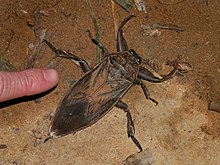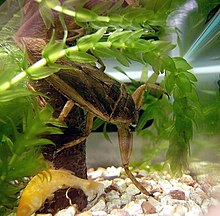タイワンタガメ属
| タイワンタガメ属 | |||||||||||||||||||||
|---|---|---|---|---|---|---|---|---|---|---|---|---|---|---|---|---|---|---|---|---|---|
 Lethocerus americanus
| |||||||||||||||||||||
| 分類 | |||||||||||||||||||||
|
タイワンタガメ属[1] (タイワンタガメぞく、Lethocerus) は、半翅目コオイムシ科に属する分類群。
世界の熱帯から亜熱帯、温帯までの地域に生息する[2][3]。最も多くの種が生息するのはアメリカ大陸で16種が生息し、ヨーロッパには1種、アフリカには2種、オセアニアには2種、アジアには3種が生息する[3]。また、この分類群には、世界最大の半翅目の種が含まれ、その最大体長は約130mm (L.maximus) 。しかし、多くの種の平均的な体長は45~90mmである[3]。また、Benacus属とは前脚に溝があるかないか、タガメ属とは体に対しての前脚の大きさで区別される。
生態
[編集]コオイムシ亜科とは異なり、オスの背中に卵を産むことは通常無い[4]。そのかわり、卵は陸上の植物や人工物などに産み付けられる。その後、オスは外敵や乾燥から卵を守るため、外敵が近づくと威嚇したり、卵に水を与えたりする[5]。

他のタガメ類と同じように、口吻によって獲物を刺し、多くの酵素を含む消化液を注入し獲物の体液を吸うことで獲物を捕食する[6]。また、消化液には 132 もの成分が検出されており、そのいくつかはサシガメに含まれる成分と類似している[7]。また、光に集まる性質を持ち、繁殖期に他の水域に飛んで移動する際によく集まる。また、タイワンタガメなどは東南アジアで食用とされており、いくつかの種は絶滅の危機に瀕している[8]。
含まれる種
[編集]

2006年現在[update]、知られているタイワンタガメ属の種は以下の通り[10]。和名は都築ほか (1999)・市川 (2009) を参考とした。
- Lethocerus americanus (Leidy, 1847) アメリカタガメ[11]
- Lethocerus angustipes (Mayr, 1871)
- Lethocerus annulipes (Herrich-Schaeffer, 1845)
- Lethocerus bruchi De Carlo, 1931[注釈 1]
- Lethocerus camposi (Montandon, 1901)
- Lethocerus collosicus (Stål, 1854)
- Lethocerus cordofanus Mayr, 1853 アフリカタガメ[11]
- Lethocerus delpontei De Carlo, 1930
- Lethocerus dilatus Cummings, 1933
- Lethocerus distinctifemur Menke, 1960
- Lethocerus grandis (Linnaeus, 1758) ナンベイオオタガメ[12][注釈 2]
- Lethocerus indicus (Lepeletier & Serville, 1825) タイワンタガメ[11]
- Lethocerus insulanus (Montandon, 1898)
- Lethocerus jimenezasuai De Carlo, 1957
- Lethocerus maximus De Carlo, 1938 ナンベイオオタガメ[11][12]
- Lethocerus mazzai De Carlo, 1961
- Lethocerus medius (Guérin-Méneville, 1857)
- Lethocerus melloleitaoi De Carlo, 1933
- Lethocerus oculatus (Montandon, 1896)
- Lethocerus patruelis (Stål, 1854)
- Lethocerus truxali Menke, 1959
- Lethocerus uhleri (Montandon, 1896) メキシコタガメ[12]、アメリカコガタタガメ[11]
この属の知られている最古の化石は、英国ワイト島のベンブリッジマールズ産の不確定種である[13]。
これらに加えて、最も有名なタガメの1つであるタガメも伝統的にこの属に含まれていたが、2006年にタガメ属に移された[10]。
脚注
[編集]注釈
[編集]出典
[編集]- ^ 『ネイチャーガイド 日本の水生昆虫』文一総合出版、2020年2月4日、330−333頁。
- ^ D. R. Lauck & A. Menke (1961). "The higher classification of the Belostomatidae (Hemiptera)". Annals of the Entomological Society of America. 54 (5): 644–657. doi:10.1093/aesa/54.5.644.
- ^ a b c P. J. Perez-Goodwyn (2006). "Taxonomic revision of the subfamily Lethocerinae Lauck & Menke (Heteroptera: Belostomatidae)". Stuttgarter Beiträge zur Naturkunde. A (Biologie). 695: 1–71.
- ^ Ichikawa, Noritaka (1988). "Male brooding behaviour of the giant water bugLethocerus deyrollei vuillefroy (Hemiptera: Belostomatidae)". Journal of Ethology. 6 (2): 121–127. doi:10.1007/BF02350877. ISSN 0289-0771. S2CID 7243491.
- ^ Smith, Robert L.; Larsen, Eric (1993). "Egg attendance and brooding by males of the giant water bugLethocerus medius (Guerin) in the field (Heteroptera: Belostomatidae)". Journal of Insect Behavior. 6 (1): 93–106. doi:10.1007/BF01049150. ISSN 0892-7553. S2CID 13472284.
- ^ Rees, A. R.; Offord, R. E. (1969). "Studies on the Protease and Other Enzymes from the Venom of Lethocerus cordofanus". Nature. 221 (5181): 675–677. doi:10.1038/221675a0. ISSN 0028-0836. PMID 5774947. S2CID 4177402.
- ^ Walker, Andrew A.; Hernández-Vargas, Maria José; Corzo, Gerardo; Fry, Bryan G.; King, Glenn F. (2018). "Giant fish-killing water bug reveals ancient and dynamic venom evolution in Heteroptera". Cellular and Molecular Life Sciences. 75 (17): 3215–3229. doi:10.1007/s00018-018-2768-1. ISSN 1420-682X. PMID 29427076. S2CID 253598647.
- ^ Yoon, Tae Joong; Kim, Dong Gun; Kim, Seon Yi; Jo, Shin Il; Bae, Yeon Jae (2010). "Light-attraction flight of the giant water bug, Lethocerus deyrolli (Hemiptera: Belostomatidae), an endangered wetland insect in East Asia". Aquatic Insects. 32 (3): 195–203. doi:10.1080/01650424.2010.508045. ISSN 0165-0424. S2CID 83801153.
- ^ a b P. J. Perez-Goodwyn (2006). “Taxonomic revision of the subfamily Lethocerinae Lauck & Menke (Heteroptera: Belostomatidae)”. Stuttgarter Beiträge zur Naturkunde. A (Biologie) 695: 1–71.
- ^ a b Ichikawa, Noritaka (1989). “Repeated copulations benefit of the female in Lethocerus deyrollei vuillefroy (Heteroptera: Belostomatidae)”. Journal of Ethology 7 (2): 113–117. doi:10.1007/BF02350032. ISSN 0289-0771.
- ^ a b c d e 『田んぼの生きものたち タガメ』農山漁村文化協会、2009年、49頁。
- ^ a b c 『水生昆虫完全飼育・繁殖マニュアル 改訂版』データハウス、2000年6月20日、58-83頁。
- ^ Szwedo, Jacek; Drohojowska, Jowita; Popov, Yuri A.; Simon, Ewa; Wegierek, Piotr (September 2019). "Aphids, true hoppers, jumping plant-lice, scale insects, true bugs and whiteflies (Insecta: Hemiptera) from the Insect Limestone (latest Eocene) of the Isle of Wight, UK". Earth and Environmental Science Transactions of the Royal Society of Edinburgh. 110 (3–4): 331–396. doi:10.1017/S175569101900001X. ISSN 1755-6910. S2CID 202183876.
関連項目
[編集]Text is available under the CC BY-SA 4.0 license; additional terms may apply.
Images, videos and audio are available under their respective licenses.
